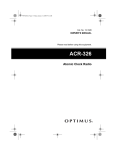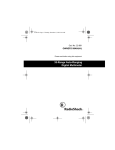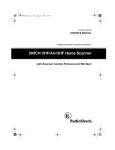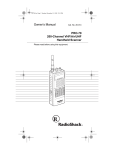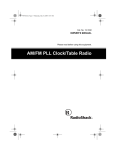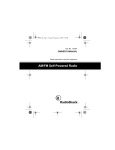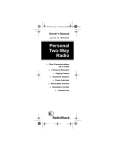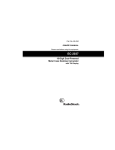Download Radio Shack Travel Sleep Mashine Owner`s manual
Transcript
20-226.fm Page 1 Tuesday, December 7, 1999 1:48 PM Cat. No. 20-226 OWNER’S MANUAL Please read before using this equipment. DX-396 AM/SW/FM Stereo PLL Portable Receiver 20-226.fm Page 2 Tuesday, December 7, 1999 1:48 PM FEATURES Your lightweight and compact RadioShack DX-396 AM/SW/FM-Stereo PLL Portable Receiver lets you choose from a wide variety of broadcasts on FM, AM, and SW (shortwave) bands. The 12 international SW bands let you tune in to the news and other programs from such sources as the British Broadcasting Company, Radio Cairo, and Radio Moscow, bringing the voices of the world to you. Tone Control — lets you set the receiver to accentuate high or low frequency sounds. Search Tuning — searches up or down the band for the next available station. Memory Scan — scans the stored frequencies in each band’s memory. LED Tuning Indicator — lights when the receiver tunes to a signal. Its features include: Dual Clock — has a primary clock, which you can set to your local time, and a secondary clock, which you can set for another time zone. Phase-Locked Loop (PLL) Synthesized Receiver — ensures accurate tuning. Direct-Access Tuning — directly tunes to the desired frequency when you enter the frequency on the keypad. Large, Fast-Response Display — shows the band, frequency, wave length (for SW), memory, battery, time, and other indicators. Memory Tuning — stores up to 30 frequencies in memory (10 frequencies in each band) so you can easily tune to your favorite stations. Shortwave Quick Select — allows you quick access to any of the 12 shortwave broadcast bands. Key Lock — prevents you from accidentally turning the receiver on or off, changing the band or frequency, or changing other front-panel controls. Alarm — sounds a buzzer or turns on the radio at a set time. Sleep Timer — plays the radio for 90, 60, 30, or 15 minutes, then automatically turns it off. Headphone Jack — lets you connect optional stereo headphones so you can listen privately and hear FM broadcasts in stereo. DX/Local Control — helps to reduce distortion of broadcasts. © 1999 Tandy Corporation. All Rights Reserved. RadioShack and Adaptaplug are registered trademarks used by Tandy Corporation. 2 20-226.fm Page 3 Tuesday, December 7, 1999 1:48 PM Three Power Options — let you power the receiver with internal batteries (not supplied), standard household AC power (using an optional AC adapter), or DC vehicle battery power (using an optional DC adapter). Memory Backup — keeps the programmed stations in your receiver’s memory for about 30 seconds without batteries. Frequency Step Switch — lets you set the correct frequency step for different countries. 12H/24H Clock Switch — lets you select a 12- or 24-hour time display. Folding Stand — securely positions the receiver at an angle. Because this product is so versatile, please take a few moments to review this Owner’s Manual before you operate your receiver. 3 20-226.fm Page 4 Tuesday, December 7, 1999 1:48 PM CONTENTS Preparation .............................................................................................................. Connecting Power .............................................................................................. Using Internal Battery Power ....................................................................... Using AC Power ........................................................................................... Using Vehicle Battery Power ........................................................................ Setting the Time ................................................................................................. Choosing the Time Format ........................................................................... Setting the Primary Clock ............................................................................ Setting the Secondary Clock ........................................................................ Setting the AM/FM Tuning Increment ................................................................. Using Stereo Headphones ................................................................................. Listening Safely ............................................................................................ Traffic Safety ................................................................................................ Using the Folding Stand ..................................................................................... 5 5 5 5 6 7 7 7 8 8 9 9 9 9 Operation ............................................................................................................... Listening to the Receiver .................................................................................. Selecting the Band ..................................................................................... Selecting the International Radio Frequency Band .................................... Tuning to a Radio Station ........................................................................... Using the Sensitivity Switch ....................................................................... Using the Antenna ..................................................................................... Storing Station Frequencies ............................................................................. Erasing Stored Frequencies ............................................................................. Listening Hints .................................................................................................. International Broadcast Frequencies ................................................................ Time Standard Frequencies ............................................................................. Frequency Conversion ..................................................................................... 10 10 10 10 11 12 12 12 13 13 13 14 14 Special Features ................................................................................................... Using the Key Lock ........................................................................................... Using the Alarm ................................................................................................ Setting the Alarm Time ............................................................................... Turning the Alarm On/Off ........................................................................... Using the Sleep Timer ...................................................................................... 15 15 15 15 15 16 Troubleshooting .................................................................................................... 17 The FCC Wants You to Know ........................................................................... 18 Specifications ........................................................................................................ 19 4 20-226.fm Page 5 Tuesday, December 7, 1999 1:48 PM PREPARATION CONNECTING POWER You can power your receiver from: • Internal battery power (two alkaline C batteries, not supplied). • Standard household AC power (with an optional AC adapter). Follow these steps to install batteries. 1. Slide the battery compartment cover in the direction of the arrow and remove the cover. OPEN SIZE”C” x2 BATTERIES • Vehicle battery power (with an optional DC adapter). Using Internal Battery Power To use battery power, you need two C batteries (not supplied). For the best performance and longest life, we recommend RadioShack alkaline batteries. Cautions: • Use only fresh batteries of the required size and recommended type. • Do not mix old and new batteries or different types of batteries. 2. Place the batteries in the compartment and on top of the attached ribbon, as indicated by the polarity symbols (+ and –) marked outside the compartment. 3. Replace the cover. When BATTERY flashes on the display or the receiver stops operating properly, replace the batteries. Warning: Dispose of old batteries promptly and properly. Do not burn or bury them. Caution: If you do not plan to use the receiver with batteries for a month, remove the batteries. Batteries can leak chemicals that can destroy electronic parts. Using AC Power You can power the receiver using a 3V, 700-mA AC adapter, such as RadioShack Cat. No. 273-1756, and a size H Adaptaplug® (neither supplied). Both are available at your local RadioShack store. 5 20-226.fm Page 6 Tuesday, December 7, 1999 1:48 PM Cautions: You must use a Class 2 power source that supplies 3V DC and delivers at least 300 mA. Its center tip must be set to positive and its plug must fit the receiver's DC 3V jack. Using an adapter that does not meet these specifications could damage the receiver or the adapter. ! • Always connect the AC adapter to the receiver before you connect it to AC power. When you finish, disconnect the adapter from AC power before you disconnect it from the receiver. • If you disconnect power from the receiver for about 30 seconds, all information stored in memory will be lost. However, if you disconnect the AC adapter plug from the receiver’s DC 3V jack and have batteries installed, the memory stays intact. Follow these steps to power the receiver from AC power. 1. Connect the Adaptaplug to the adapter’s cord with the TIP set to +POS. 2. Insert the barrel plug into the receiver’s DC 3V jack. This disconnects the internal batteries. 3. Plug the adapter into a standard AC outlet. 6 Using Vehicle Battery Power You can power the receiver from a vehicle’s 12V power source (such as cigarette-lighter socket) using a 3V, 300-mA DC adapter and a size H Adaptaplug (neither supplied). Both are available at your local RadioShack store. Cautions: You must use a power source that supplies 3V DC and delivers at least 300 mA. Its center tip must be set to positive and its plug must fit the receiver's DC 3V jack. Using an adapter that does not meet these specifications could damage the receiver or the adapter. ! • Always connect the DC adapter to the receiver before you connect it to the power source. When you finish, disconnect the adapter from the power source before you disconnect it from the receiver. • If you disconnect power from the receiver for about 30 seconds, all information stored in memory will be lost. However, if you disconnect the DC adapter plug from the receiver’s DC 3V jack and have batteries installed, the memory stays intact. 20-226.fm Page 7 Tuesday, December 7, 1999 1:48 PM Follow these steps to power your receiver from your vehicle’s battery power. 1. Set the adapter’s voltage switch to 3V. 2. Connect the Adaptaplug to the adapter’s cord with TIP set to +POS. 3. Insert the adapter's barrel plug into the receiver’s DC 3V jack. This disconnects the internal batteries. 4. Plug the other end of the adapter into your vehicle’s cigarette-lighter socket. SETTING THE TIME The receiver has a dual time clock so you can set the primary clock for your local time and the secondary clock for another time zone. You can select a 12- or 24-hour clock display format. Choosing the Time Format 1. Slide the battery compartment cover in the direction of the arrow and remove the cover. 2. Remove any batteries from the compartment. 3. Set CLOCK to 12H for a 12-hour format or to 24H for a 24-hour format. Setting the Primary Clock Follow these steps to set your local time. 1. Press POWER to turn on the receiver. FM 87.50 MHz appears on the display. 2. Press CLOCK. flashes. 12:00 slowly 3. Press TIME SET. 12:00 rapidly flashes for 60 seconds. 4. Use the number keys to enter the correct time while the display flashes. For example, to enter 9:30 AM, press 9, 3, and 0. To enter a PM time, press MEMORY/ STORE AM/PM. pm 9:30 appears on the display. Note: You can use > or < to set the time instead of using the number keys. Press > to advance the time or < to set the time back. 5. Press TIME SET again when the time shows correctly. The display stops flashing, and the clock starts. Notes: • If you set the time using the time tone from a time standard frequency, press TIME SET when the time tone sounds to synchronize the seconds. (See “Time Standard Frequencies” on Page 14.) 4. Replace the batteries. 5. Replace the cover. 6. Press POWER to turn on the receiver and activate the format change. 7 20-226.fm Page 8 Tuesday, December 7, 1999 1:48 PM • When the receiver is off, the display always shows local time. When the receiver is turned on, the time disappears and a radio frequency appears. To see the time when the receiver is on, press CLOCK. Press CLOCK again to return to the radio frequency display. Setting the Secondary Clock Follow these steps to set the secondary clock. 1. Press POWER, then press DUAL TIME. WORLD TIME appears. 2. Press TIME SET. The hour digit and WORLD TIME flash for 10 seconds. 3. While the display flashes, use the number keys to enter the hour for the secondary clock. Or, press > to advance the hour or < to set it back. Notes: • The minutes change automatically, according to the primary clock setting. • If the clock is in 12-hour format and you press > or < to set the hour, PM automatically appears on the display. If you use the number keys to enter the hour, press AM/PM to note the time is PM. 4. Press TIME SET again to set the secondary clock. To see the secondary clock time, press DUAL TIME. The display shows the time and WORLD TIME for 10 seconds, then automatically 8 returns to the primary clock time or the radio frequency display (when the receiver is on). To return to the primary clock or radio frequency display before 10 seconds have passed, press DUAL TIME again. SETTING THE AM/FM TUNING INCREMENT You can set the AM/FM tuning increment to the correct frequency used in other countries as you travel. 1. Slide the battery compartment cover in the direction of the arrow and remove the cover. 2. Remove any batteries from the compartment. 3. To easily receive broadcasts when you travel to other countries, set A/B to A. To easily receive broadcasts at home, set A/B to B. For example, 10 kHz is used in North and South America, while 9 kHz is dominant in Europe. 4. Replace the batteries. 5. Replace the cover. 20-226.fm Page 9 Tuesday, December 7, 1999 1:48 PM USING STEREO HEADPHONES For private listening, connect optional stereo headphones into the receiver's 1/ 8-inch jack. Your local RadioShack store offers a wide selection of stereo headphones. Note: The built-in speaker disconnects when you plug in headphones. Listening Safely To protect your hearing, follow these guidelines when you use headphones. If you use headphones with your receiver while riding a bicycle, be very careful. Do not listen to a continuous broadcast. Even though some headphones let you hear some outside sounds when listening at normal volume levels, they still can present a traffic hazard. USING THE FOLDING STAND You can use the stand on the back of the receiver to prop it up so you can easily see the clock display. Simply lift the stand away from the receiver and set the receiver on a flat surface. • Set the volume to the lowest setting before you begin listening. After you begin listening, adjust the volume to a comfortable level. • Do not listen at extremely high volume levels. Extended high-volume listening can lead to permanent hearing loss. • Once you set the volume, do not increase it. Over time, your ears adapt to the volume level, so a volume level that does not cause discomfort might still damage your hearing. The back of the stand shows a world map with time zone changes. You can use the map to help you set the Secondary Clock to determine broadcast times in other parts of the world. Traffic Safety Do not use headphones with your receiver when operating a motor vehicle or riding a bicycle in or near traffic. Doing so can create a traffic hazard and could be illegal in some areas. 9 20-226.fm Page 10 Tuesday, December 7, 1999 1:48 PM OPERATION LISTENING TO THE RECEIVER Press BAND until the desired band (FM, MW, or SW) appears on the display. Warning: To prevent possible ear injury and hearing loss, set VOLUME to minimum before you turn on the receiver. After you turn on the receiver, set VOLUME to a comfortable listening level. Follow these steps to listen to the receiver. • If you select FM, FM, MHz, and STEREO (when you tune to a stereo broadcast) appear on the display. Note: Your receiver has only one speaker. To listen to a stereo broadcast, use stereo headphones (not supplied). (See “Using Stereo Headphones” on Page 9.) the • If you select MW, MW and kHz appear on the display. 2. Press BAND until the desired band (FM, MW, or SW) appears on the display. (See “Selecting the Band.” ) • If you select SW, SW BROADCAST BAND, m, SW, and kHz appear on the display. See “Selecting the International Radio Frequency Band.” to select each international radio frequency band. 1. Press POWER receiver. to turn on 3. Press < or > or the number keys (0 – 9) to tune to the desired station. (See “Tuning to a Radio Station” on Page 11.) 4. Adjust your receiver’s antenna for the best reception. (See “Using the Antenna” on Page 12.) 5. Adjust VOLUME desired. 6. Press POWER receiver. and to TONE turn off as the Selecting the Band You can select the Frequency Modulation (FM), Medium wave (MW), or the 12-band Shortwave (SW) band for operation. Note: The medium wave band is also known as the Amplitude Modulation (AM) band due to its modulation system. 10 Note: SW BROADCAST BAND and m only appear on the display if you select an SW frequency that falls between the ranges printed on the SHORTWAVE BANDS chart printed below the display. Selecting the International Radio Frequency Band If you select the shortwave band, you can further choose one of the 12 international radio frequency bands using SW SELECT. Follow these steps to directly select one of the 12 SW radio broadcast bands. 1. Press BAND to select shortwave band. 20-226.fm Page 11 Tuesday, December 7, 1999 1:48 PM 2. Press SW SELECT. m (meter) flashes for 10 seconds. 3. While m flashes, press the desired band key (120m - 13m). The receiver tunes to the lowest frequency in the selected band. Tuning to a Radio Station You can tune to a station using the manual, search, direct access, preset, or scan tuning methods. • Up-Down Manual To manually tune to a frequency, repeatedly press < or > until the display shows the desired frequency. • Search To let the receiver find a station, press and hold < or > for more than 2 seconds. The tuner rapidly scans all frequencies. When you release the button, the receiver automatically tunes to the next strong station. Note: As the receiver rapidly scans for a station, you will be able to hear the sounds broadcast from the passing frequencies. • Direct Access To tune directly to a station’s frequency, press ENTER. ENTRY flashes for about 10 seconds. While it is flashing, press the number buttons to select the desired station’s frequency. Then press ENTER again. Notes: • Your receiver automatically rounds the entered frequency to the nearest valid frequency. For example, if you try to enter a frequency of 1453 in AM, your receiver accepts it as 1450. (See “Setting the AM/FM Tuning Increment” on Page 8.) • If you make a mistake in entering a frequency, EEEE flashes on the display. Enter the frequency again. • Preset To tune directly to a station that is entered into memory, simply press the desired preset number (0–9). Note: You must first store the desired stations into memory. (See “Storing Station Frequencies” on Page 12.) • Scan To scan the preset memory locations, press SCAN. The receiver stops at each station for about 5 seconds. To end scanning, press SCAN again, or press a preset station memory button. Note: If no frequency is stored in a memory channel or no signal is received at a memory channel, the receiver stops at the memory channel for 1 second and then moves to the next memory channel. 11 20-226.fm Page 12 Tuesday, December 7, 1999 1:48 PM Using the Sensitivity Switch If you are listening to a strong FM, AM, or SW station, and the sound is distorted, set the sensitivity switch to LOCAL. This decreases the receiver’s sensitivity which reduces distortion from strong signals and prevents reception of weak and noisy signals which are more common. If you are listening to a weak station, set the sensitivity switch to DX (distant). This increases the receiver’s sensitivity and improves the station’s reception. store a station’s frequency using a memory button, you can press this button to select the stored station. Caution: If you disconnect power from the receiver for about 30 seconds, all information stored in memory will be lost. However, if you disconnect the AC or DC adapter plug from the receiver’s DC 3V jack and have batteries installed, the memory stays intact. Follow these steps to store a frequency in memory. Using the Antenna 1. Press POWER receiver. Use the following guidelines to adjust your receiver’s antenna. 2. Press BAND until the desired band (FM, MW, or SW) appears on the display. Band Antenna Adjustments 3. Press < or > or the number keys (0 – 9) to tune to the desired station. FM Fully extend and rotate the telescoping antenna. AM Rotate the receiver. (AM uses an internal antenna.) SW Fully extend the telescoping antenna. STORING STATION FREQUENCIES For easy selection, you can store up to 30 of your favorite stations’ frequencies in memory (10 frequencies in each band; FM, MW, and SW). Once you 12 turn on the 4. Adjust your receiver’s antenna for the best reception. Note: Use manual, search, or direct access tuning to tune to the station’s frequency you want to store. 5. Press Note: For better AM and SW reception, you can connect an external antenna to the telescoping antenna. to MEMORY/STORE/AM/PM. MEMORY flashes. 6. While MEMORY flashes, press a number button to select the memory location. Note: If you do not press a number within about 10 seconds, MEMORY stops flashing and you must repeat Step 5. 20-226.fm Page 13 Tuesday, December 7, 1999 1:48 PM ERASING STORED FREQUENCIES Your shortwave receiver permanently keeps programmed stations stored in memory. However, you can erase all or single stored frequencies from the memory buttons. To clear all the memory buttons, you must reset the receiver. Note: Resetting the receiver clears the current clock settings. Using a straightened paper clip, press RESET (located on the bottom of the re- ceiver) once. 12:00 flashes on the display. Then reset the primary and secondary clocks. To clear a single memory button, press MEMORY/STORE/AM/PM. Press the memory location button, dELE appears. Then press ENTER to clear the memory location. LISTENING HINTS Listening to shortwave radio can be very exciting. Newscasts from a country where important events are taking place give you a sense of immediacy that local newscasts seldom deliver. Although shortwave listening requires no special knowledge, you might enjoy it more if you read some of the numerous books available on this subject. There are also several periodicals that give listening hints and seasonal program schedules. INTERNATIONAL BROADCAST FREQUENCIES International commercial broadcasts are found in the following bands. Programming (often in English) usually contains news, commentaries, music, and special features reflecting the culture of the broadcasting country. You might find it easiest to hear these broadcasts between 6:00 PM and midnight (your time). Note: European stations often list a frequency by giving its wavelength. For example, the 19-meter band refers to the range of frequencies whose waves are about 19 meters long. Band (In meters) Frequency Range (In MHz) *120 2.300-2.495 *90 3.200-3.400 75 3.900-4.000 *60 4.750-5.060 49 5.950-6.200 **41 7.100-7.300 31 9.500-9.900 25 11.650-12.050 22 13.600-13.800 19 15.100-15.600 16 17.550-17.900 13 21.450-21.850 *These bands are reserved for stations in tropical areas. 13 20-226.fm Page 14 Tuesday, December 7, 1999 1:48 PM **The 41-meter band is shared by ham operators in the United States and international stations. FREQUENCY CONVERSION TIME STANDARD FREQUENCIES The location of a station can be expressed in frequency (KHz or MHz) or in wavelength (meters). The following information can help you make the necessary conversions. The following frequencies announce the exact time of day at specified intervals for the United States. 2.500 MHz WWV Fort Collins, Colorado: 5.000 MHz To convert from MHz to kHz, multiply by 1,000. For example: 9.62 MHz x1,000=9,620 kHz 10.000 MHz 15.000 MHz 20.000 MHz To convert from kHz to MHz, divide by 1,000. For example: 10.000 MHz WWVH Kauai, Hawaii: 20.000 MHz Note: Other countries also have signal stations transmitting this type of information over WWV or WWVH. You can find more information about time standard frequencies in Canada at www.inms.nrc.co/ inms.chu.html or in Japan at www.crl.go.jp/cgi-bin/nph-watch. 14 15,500 kHz/1,000 = 15.5 MHz 15.000 MHz To convert from MHz to meters, divide 300 by the number of MHz. For example: 300/12 MHz = 25 meters 20-226.fm Page 15 Tuesday, December 7, 1999 1:48 PM SPECIAL FEATURES USING THE KEY LOCK The lock feature prevents you from accidentally turning the receiver on or off, changing the band or frequency, or changing other front-panel controls. You can still adjust VOLUME, TONE, and the sensitivity switch. IN. To lock the controls, set LOCK to LOCK appears on the display. To unlock the controls, set LOCK to . LOCK disappears from the display. Note: If you press a “locked” button, briefly flashes on the display. USING THE ALARM Setting the Alarm Time You can set an alarm so the buzzer sounds or the receiver plays at a specified time. Follow these steps to set the alarm time. 1. Hold down SET/OFF, BUZZER or STANDBY appear. Press TIME SET, the display flashes. Release SET/OFF and TIME SET. 2. While the display flashes, use the number keys to enter an alarm time. If the time is p.m. press STORE AM/ PM once. 3. Press TIME SET again. The alarm time is set. The display returns to the radio frequency display if you have the power on. When you set an alarm time, the buzzer or radio (standby) is preset for the alarm sound. To choose the other alarm sound, see “Turning the Alarm On/Off.” Note: To view the set alarm time, press SET/OFF. This turns off the alarm. Press SET/OFF again to turn the alarm back on. Turning the Alarm On/Off 1. Set the receiver to the desired station and volume. 2. Press SET/OFF to display either BUZZER or STANDBY , then: • To have the buzzer sound at the alarm time, press ALARM/STANDBY until BUZZER appears. • To have the radio turn on at the alarm time, press ALARM/STANDBY until STANDBY appears. 3. If the buzzer alarm is turned on, at the preset alarm time, the buzzer sounds for about an hour, and the radio also plays. If the radio alarm is turned on, at the preset alarm time, the radio plays for 1 hour. Note: If you want to use the buzzer for the alarm, set VOLUME to its minimum position. 4. To turn off the alarm, press POWER. The alarm sounds again the next day at the specified alarm time. 15 20-226.fm Page 16 Tuesday, December 7, 1999 1:48 PM To turn off the alarm so it will not sound again the next day, press SET/OFF. BUZZER or STANDBY disappears when the alarm is turned off. USING THE SLEEP TIMER The sleep timer sets the radio to turn off after 90, 60, 30 or 15 minutes so you can fall asleep as you listen to the radio. To set the sleep timer, press SLEEP. The radio turns on, SLEEP flashes and 90 appears briefly. After 90 minutes, the radio turns off automatically. If you want to set a shorter sleep time, press SLEEP repeatedly to select 60, 30, or 15 minutes. Note: Each time you press SLEEP, the remaining sleep time appears briefly. To turn off the radio before it automatically turns off, press POWER. 16 20-226.fm Page 17 Tuesday, December 7, 1999 1:48 PM TROUBLESHOOTING Your receiver should give you years of trouble-free service if you follow the care instructions given in this manual. If you do have problems, the chart below might help you solve them. Problem No display or incorrect display. Probable Cause Solution • Batteries are weak or dead. • Replace the batteries. • AC or DC adapter is plugged into the receiver but not into the power source. (Plugging an adapter into the receiver automatically disconnects the receiver’s batteries. • Connect the adapter to the AC or DC power source. • Adjust DC adapter to proper voltage position. • DC adapter’s voltage is set to the wrong position. • Batteries are weak or dead. • Replace the batteries. • VOLUME is set too low. • Adjust desired. • Headphones are plugged into the receiver. (This disconnects the speaker.) No sound. Weak sound, intermittent sound, or poor sensitivity. as VOLUME • Disconnect phones. the head- • AC or DC adapter is plugged into the receiver but not into the power source. (Plugging an adapter into the receiver automatically disconnects the receiver’s batteries.) • Connect the adapter to the AC or DC power source. • Batteries are weak. • Replace the batteries. • The sensitivity switch is set to LOCAL. • Set it to DX. • Antenna needs adjusting. • Metal is blocking the signal. • Adjust the antenna. • Move the receiver near a window when operating it inside a vehicle or metal frame building. Controls do not function. Key is locked. LOCK appears on the display. LOCK to the other Set position. Display does not show the band and frequency for the receiver. The clock display is selected. Press CLOCK to change the display. 17 20-226.fm Page 18 Tuesday, December 7, 1999 1:48 PM Problem Probable Cause Solution Clock flashes. The receiver had a power interruption. Set the time. Tuning does not stop. The sensitivity switch is set to LOCAL. If the signal is weak, the receiver does not stop in LOCAL. Set it to DX. Scan tuning does not stop. • Receiver is set to memory scan. • Press SCAN or press the number key. • No incoming signal scans in LOCAL. • Set it to DX. or THE FCC WANTS YOU TO KNOW Your RadioShack DX-396 AM/SW/FM-Stereo PLL Portable Receiver might cause television or radio interference even when it is operating properly. To determine whether your receiver is causing the interference, turn it off. If the interference goes away, your receiver is causing the interference. To try to eliminate the interference: • Reorient the DX-396 receiver’s antenna. • Move your DX-396 receiver away from the television or radio receiver. • Connect your DX-396 receiver to an outlet that is on a different electrical circuit from the television or radio receiver. • Contact your local RadioShack store for assistance. If you cannot eliminate the interference, the FCC requires that you stop using your receiver. 18 20-226.fm Page 19 Tuesday, December 7, 1999 1:48 PM SPECIFICATIONS Frequency Range (with frequency step switch set to AM 10 kHz FM 200 kHz): FM.................................87.5-108.0 MHz AM ................................... 530-1710 kHz SW ............................... 2300-21850 kHz ( . . . set to AM 9 kHz FM 100 kHz): Jacks: External Power............................DC 3V, Center Positive Stereo Headphones .................. 1/8 inch Speaker...................... 3 Inches (77 mm) Permanent Magnet, Dynamic Type FM.................................87.5-108.0 MHz Power Output: AM ................................... 531-1710 kHz Speaker................ 350 mW at 10% THD SW ............................... 2300-21850 kHz Headphones..... 35 mW x 2 at 10% THD 32 ohm SW Sub-Bands: 120 meter..................... 2,300-2,495 kHz 90 meter....................... 3,200-3,400 kHz 75 meter....................... 3,900-4,000 kHz 60 meter....................... 4,750-5,060 kHz 49 meter....................... 5,950-6,200 kHz 41 meter....................... 7,100-7,300 kHz 31 meter....................... 9,500-9,900 kHz 25 meter................... 11,650-12,050 kHz 22 meter...................13,600-13,800 kHz 19 meter...................15,100-15,600 kHz 16 meter...................17,550-17,900 kHz 13 meter...................21,450-21,850 kHz Antennas: FM....................................... Telescoping AM ...................................Built-In Ferrite SW ..................... (2,3 MHz - 7,095 MHz) Built-In Ferrite SW ............... (7,100 MHz - 21,850 MHz) Telescoping Battery Life at 10 mW.............. 60 Hours (Alkaline Battery) Power Source: Internal Batteries ...........Two C Batteries (3 Volts) AC Power ................................ 120 Volts with Optional AC Adapter Vehicle Battery .......................... 12 Volts with Optional DC Adapter Sleep Timer ....... 90, 60, 30, 15 minutes; Auto-off Dimensions (HWD): 7 5/16 x 4 3/4 x 1 1/2 Inches (186.5 x 120 x 38.5 mm) Weight ...............................18 oz (503 g) (without batteries) Specifications are typical; individual units might vary. Specifications are subject to change and improvement without notice. 19 20-226.fm Page 20 Tuesday, December 7, 1999 1:48 PM Limited Ninety-Day Warranty This product is warranted by RadioShack against manufacturing defects in material and workmanship under normal use for ninety (90) days from the date of purchase from RadioShack companyowned stores and authorized RadioShack franchisees and dealers. EXCEPT AS PROVIDED HEREIN, RadioShack MAKES NO EXPRESS WARRANTIES AND ANY IMPLIED WARRANTIES, INCLUDING THOSE OF MERCHANTABILITY AND FITNESS FOR A PARTICULAR PURPOSE, ARE LIMITED IN DURATION TO THE DURATION OF THE WRITTEN LIMITED WARRANTIES CONTAINED HEREIN. EXCEPT AS PROVIDED HEREIN, RadioShack SHALL HAVE NO LIABILITY OR RESPONSIBILITY TO CUSTOMER OR ANY OTHER PERSON OR ENTITY WITH RESPECT TO ANY LIABILITY, LOSS OR DAMAGE CAUSED DIRECTLY OR INDIRECTLY BY USE OR PERFORMANCE OF THE PRODUCT OR ARISING OUT OF ANY BREACH OF THIS WARRANTY, INCLUDING, BUT NOT LIMITED TO, ANY DAMAGES RESULTING FROM INCONVENIENCE, LOSS OF TIME, DATA, PROPERTY, REVENUE, OR PROFIT OR ANY INDIRECT, SPECIAL, INCIDENTAL, OR CONSEQUENTIAL DAMAGES, EVEN IF RadioShack HAS BEEN ADVISED OF THE POSSIBILITY OF SUCH DAMAGES. Some states do not allow the limitations on how long an implied warranty lasts or the exclusion of incidental or consequential damages, so the above limitations or exclusions may not apply to you. In the event of a product defect during the warranty period, take the product and the RadioShack sales receipt as proof of purchase date to any RadioShack store. RadioShack will, at its option, unless otherwise provided by law: (a) correct the defect by product repair without charge for parts and labor; (b) replace the product with one of the same or similar design; or (c) refund the purchase price. All replaced parts and products, and products on which a refund is made, become the property of RadioShack. New or reconditioned parts and products may be used in the performance of warranty service. Repaired or replaced parts and products are warranted for the remainder of the original warranty period. You will be charged for repair or replacement of the product made after the expiration of the warranty period. This warranty does not cover: (a) damage or failure caused by or attributable to acts of God, abuse, accident, misuse, improper or abnormal usage, failure to follow instructions, improper installation or maintenance, alteration, lightning or other incidence of excess voltage or current; (b) any repairs other than those provided by a RadioShack Authorized Service Facility; (c) consumables such as fuses or batteries; (d) cosmetic damage; (e) transportation, shipping or insurance costs; or (f) costs of product removal, installation, set-up service adjustment or reinstallation. This warranty gives you specific legal rights, and you may also have other rights which vary from state to state. RadioShack Customer Relations, 200 Taylor Street, 6th Floor, Fort Worth, TX 76102 We Service What We Sell 04/99 RadioShack A Division of Tandy Corporation Fort Worth, Texas 76102 12A99 Printed in Hong Kong





















